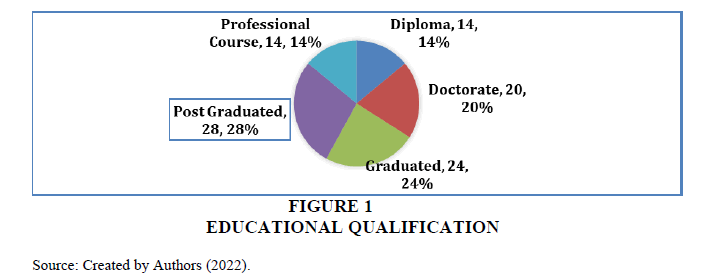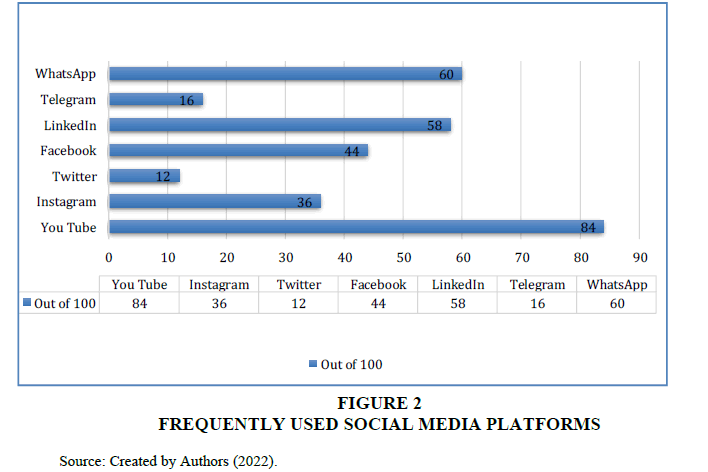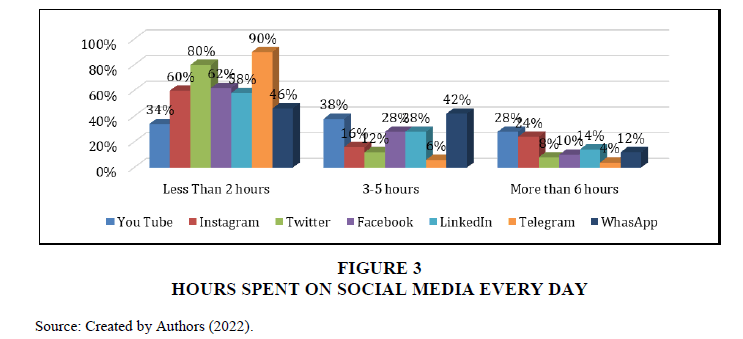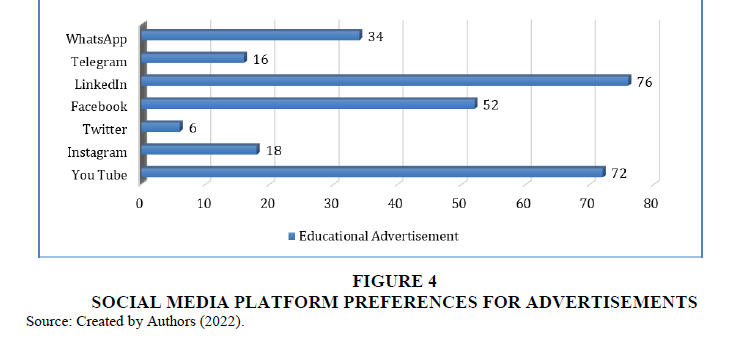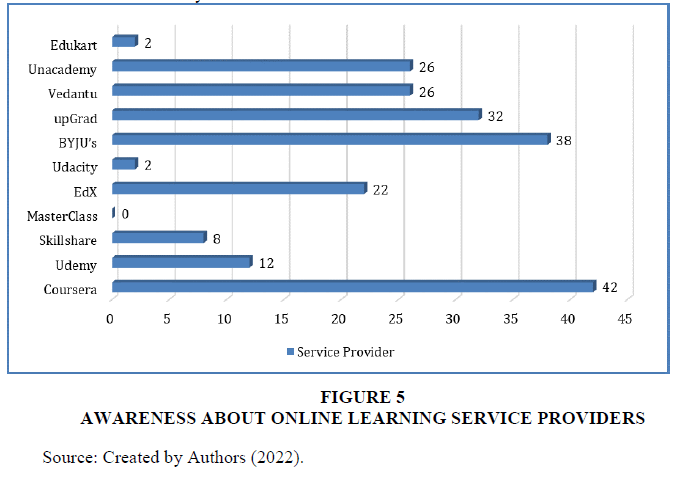Review Article: 2023 Vol: 27 Issue: 4
Analysis of Effectiveness of Social Media Marketing in the Digital Education Industry
Satish G Athawale, H K Institute of Management Studies and Research Jogeshwari (w) Mumbai
Satish M Dhoke, Moreshwar Arts Science and Commerce College, Bhokaradan, Dist. Jalna
Citation Information: Athawale, S.G., & Dhoke, S.M. (2023). Analysis of effectiveness of social media marketing in the digital education industry. Academy of Marketing Studies Journal, 27(4), 1-12.
Abstract
Information technology transformed the way we manage our personal lives and business relationships by the late 20th century. Computers, the Internet, and smart phones are no longer just machines, but almost personal assistants. When it comes to learning, people can enroll in online courses that do not need to be restricted by four walls. Instead, the mobile phone/laptop/desktop has taken on the role of trainer. In business operations, terms like e-content, and e-learning are used to meet the needs of learners. Designing e-course content and disseminating knowledge and skills is a recent service-oriented business model in which educational institutions meet the educational needs of learners (consumers) in an online mode. The e-content or online course is now considered a product. In order to sell the product, educational organizations must promote it. Given the prevailing patterns of information technology, social media is viewed as a platform to promote e-content or courses. While perceived as a distraction in the flow of communication, social media promotions on e-courses are accepted and responded to by users of social media sites like Facebook, Instagram, Telegram, YouTube, WhatsApp, etc. So this research work. attempted to examine the impact of promoting educational content via social media. However, social media is used by educational institutions like BYJUs, EdX, Coursera, unacademic, etc. as a platform to market their products. The study, therefore, finds that social media, as an advertising or marketing platform, positively influences professional and non-professional users by exposing them to effortless learning.
Keywords
Social Media Marketing, Online Education Industry, Business, Entrepreneurs. Job Opportunities, Challenges.
Introduction
The learning process never stops. A learner with zeal and enthusiasm will look for one way or another in any situation to get material, direction, etc Ahmad et al. (2021). For example, the last few years of the pandemic have not stopped people from acquiring knowledge and skills. People have now adapted to new possibilities of teaching and learning platforms Ahmad & Wasiq (2012). Given the urgent need to learn and update to survive in changing scenarios, disciplines such as management studies and information technologies must be ready to meet learners' needs. In this direction, the Internet sources, websites, applications/programs and service companies have reoriented their modalities and allowed learners to continue their passion Behrend (2018). Therefore, it is very interesting to know how the changing learning environment has triggered a new perspective on factors involved in the dissemination of educational content Buyer, (2013). In particular, the overuse of computer and web-based modalities for the delivery of educational instruction had prompted researchers and academics to question the role of social media or social networking websites/platforms in shaping educational content, engaging consumers and enhancing the learning experience of examine consumers or learners Cohen (2011). Many disasters have come and gone in human history, but we humans have learned a lesson or two and sustained ourselves on this globe Gu & Shanshan (2012). One of the fundamental characteristics that keep learning flowing is the way we strategize, cooperate and strategize for ourselves while dealing with compelling forces of nature, whether it is, in short, natural or are man-made. Skills like management have allowed us to better face any adversity in recent years as we have learned to spot problems, organize resources, strategize and plan future courses of action Haenlein et al. (2011). In this regard, the management discipline has carved a niche in the learning environment, especially under adverse circumstances such as Covid-19. The Covid-19 pandemic, for example, seemed to halt the teaching-learning process forever. However, thanks to pedagogical technology and management principles. Because of his implementation and practice of redesigning educational content and marketing strategies to reach learners in need, we have been able to keep our morale up even in chaotic situations. A desire to keep learning, deriving solutions, etc. further boosted our morale through a technology-enhanced learning environment. People in India, for example, have never been so used to using technology to learn in the last two decades. Not only children were able to continue their formal education, professionals also resorted to online platforms to keep their enthusiasm for learning alive.
Literature Review
Social Media Marketing is about understanding how technology is making it easier for people to connect socially with their social networks and how your business can profit from that understanding. More and more of your customers, whether for personal use, business-to-consumer or business-to-business reasons use social media in every aspect of their daily life. There is a common misconception that social media and social networking sites (SNS) are two synonymous terms. Social media are tools for sharing and discussing information. It can be described as a kind of online media which encourages every member for feedback and contribution. It is a social instrument of two way communication facilitating the sharing of information between users within a defined network via web 2.0 Kaplan & Haenlein, (2010).
It involves online activities in which the user contributes to content creation. This media encourages user involvement which can be as simple as posting comments or giving votes or as complex as recommending content to other user on the basis of preferences of people with similar interests and lifestyle. Thus social media can be described as a broad term inclusive of activities where people create content, share it, bookmark it and network at a phenomenal rate. On the other hand social networking sites are a place where in one forms communities of interest to connect to others. Social networking sites utilize social media technology to connect with people and build relationships. Social networking sites allow individuals to construct their profile within a bounded system, share with other users and view and traverse their list of connections and those made by others within the system Mathur & Prashant (2012). It can be thus concluded that social networking sites are a form of social media. The increasing dependence on technology for basic communication highlights the importance of analyzing how these networking sites are affecting daily processes. Anyone including teens and young adults, women, men, affluent consumers, and older individuals can join a social network site. Once registered the person can begin to socialize and create his/her own network of friends with common interests or goals. Sites like Face book, Twitter, LinkedIn are influencing the way users establish, maintain and cultivate a range of social relationships, from close friendships to casual acquaintances. Consumers today want to be more informed about products before they make the purchase. Most importantly, social networks are extremely capable of informing and influencing purchase decisions, as many users now trust their peer opinions more than the marketing strategists. Customers now have the power to talk back at the brand and broadcast their opinions of the brand. Social media is one of the most effective marketing platforms that companies use to increase customer loyalty and attract new customers while retaining existing customers. In addition, it has enabled the establishment of new customer relationships to increase customer satisfaction Olenski, (2017); Paranawithana et al. (2020) noted that social media marketing refers to the use of social media platforms such as Instagram, Twitter, Facebook, MySpace, and LinkedIn to market a company's products or services and reach a broader customer base. So, social media marketing is the practice where marketers use social media technologies, platforms and software to connect with people and deliver their products and services to stakeholders.
It found that customer satisfaction refers to the emotional response to the mismatch between customer expectations and what the company is offering in order to satisfy the company's needs or wants or offerings. Customer satisfaction significantly influences or influences customer purchase intentions, loyalty, and behavior. Effectiveness of social media is proved through the Customer Engagement it provides to the companies and their respective social site pages as one of the main purposes of the companies for being in the social sites is to engage the customers with their brand.
Customer engagement is dependent on three variables which are quality of content, user experience and frequency of visit of the customers. Like, if the quality of the content that are posted in social media sites by the respective companies is good, then it brings more customer engagement as customers are more engaged with better contents they find in social media when customers frequently visit the social media pages of a particular company, it also brings customer engagement for the company as the customers are liking to spend time in their pages and going back again and again to their sites. The more the customers visit a site, the more they likely to engage with that.
Moreover, when the user experience of the customers is better, it also provides customer engagement as the customers are satisfied with the experience they are getting while visiting social sites of any company.
Research Methodology
This research paper tried to examine the effectiveness of social media marketing in online education industry it is imperative to adopt strategies to look out for response time, response language, and frequency of promotional messages posted on social media platforms.
A quantitative analysis of data related to the online education industry which targeted working professional groups for providing advertisement through social media marketing will enable us to study the marketing strategies adopted by firms and predict the future trends to achieve consumer satisfaction on the one hand and the role of social media as marketing platform without hurting the privacy of the consumers.
Objectives of the Study
The primary objectives of the study are as follows:
• To understand the nature of social media and E-learning, and to examine the feasibility of social media sites in the promotion of educational content;
• To study the purposes, prospective consumers, challenges faced by e-content developers while promoting E-learning;
• To study the online learning needs and purposes of working professionals;
• To examine the influence of social media marketing on the purchasing power of consumers;
Hypotheses of the Study
The hypothesis must have great importance as it gives direction, a particular idea and gives a focal point to the research study.
• Social Media Marketing influences purchasing power of consumers.
• Working professionals rely on social media to search for services, service providers, and products.
• Social Media Marketing stimulates and maintains customers’ E-learning passion until the consumers make decisions to purchase the course.
• Social Media Marketing (SMM) determined the prospect of the online education industry.
Descriptive design was essential to the quantitative research method to collect quantifiable data that will be utilized for statistical analysis of the population sample.
Convenience Sampling Method
Convenience sampling or non-probability was used because the survey was conducted with questionnaires distributed via social media platforms: LinkedIn, Telegram, Instagram, WhatsApp, Twitter, Facebook, etc. Furthermore, the researchers used the selection form, a sequential list method, to select survey respondents (users/working and non-working people). This ensured an equal chance of being selected and ensured a fair chance in the selection process for the research study.
Sample Size
Determining the study populations and calculating the sample sizes are important issues for research success (Garg, 2018). In this research, the study population selected will comprise social media platform users (working and non-working people). The sample size will include 100 participants.
A recruitment email and Google Form link were shared with different all the participants requesting their participation. Thus, the participants who took part in this study were only 100 social media platform users. The participants to be questioned were selected using convenience sampling, which reduced cases of bias during the sampling of the study sample because of the big population (Kothari, 2016).
Data Collection Process
Primary Data
The authors contacted the 100 participants to seek their consent and distributed the survey questionnaires among them.
Survey Questionnaires
The data is analyzed using an IBM SPSS version 26 to determine the effectiveness of social media marketing on education industry. Different statistical tests are also used to analyze the data.
Secondary Data
Secondary data collection aids in determining the most convenient techniques to be used for the sake of achieving the study goals. The secondary data will be used to make a comparison with the primary data findings and make inferences, as well as conclusions - an essential role in research (Garg, 2018).
Data Analysis Technique
This data was entered into Excel, and then to IBM SPSS for visualization as well as in-depth analysis.
Demographic Characteristics of the Study Participants
This subsection discusses the gender, among other characteristics of participants.
Gender
Tables 1 & 2 shows the gender distribution of participants in the study.
| Table 1 Gender Wise Representation Of Respondents |
|||
|---|---|---|---|
| Sr. No | Gender | Total no of Respondents | Percent |
| 1 | Female | 28 | 28 % |
| 2 | Male | 72 | 72 % |
| Total | 100 | 100.0 | |
Source: Field Survey (2022).
| Table 2 Age Group Of The Respondent |
|||
|---|---|---|---|
| Sr. No | Age Group | Respondents | Percent |
| 1 | 15 to 25 Years | 30 | 30 % |
| 2 | 26 to 35 Years | 50 | 50 % |
| 3 | 36 to 45 Years | 12 | 12 % |
| 4 | More than 36 Years | 08 | 08 % |
| Total | 100 | 100.0 | |
Source: Field Survey (2022).
Age Group of the Respondents
The Educational Qualification
The awareness of the basic educational qualification of the respondents is very important for the data analysis of the view and impact of social media marketing on online education Table 3.
| Table 3 Educational Qualification |
|||
|---|---|---|---|
| Sr. No | Educational Qualification | Respondents | Percent |
| 1 | Diploma | 14 | 14 % |
| 2 | Doctorate | 20 | 20 % |
| 3 | Graduated | 24 | 24 % |
| 4 | Post Graduated | 28 | 28 % |
| 5 | Professional Course | 14 | 14 % |
| Total | 100 | 100 % | |
Source: Field Survey (2022).
The above Table 4 and Figure 1 is shows the five different educational qualification criteria for their education and course completion.
| Table 4 Working Status |
|||
|---|---|---|---|
| Sr. No | Working Position | Respondents | Percent |
| 1 | No | 14 | 14 % |
| 2 | Yes | 86 | 86 % |
| Total | 100 | 100 % | |
Source: Field Survey (2022)
Working Status of the Respondents
The following is Table 5 & Figure 5 is Represent the working position of the respondents.
| Table 5 Job Description / Main Profession |
|||
|---|---|---|---|
| Sr. No | Job Description / Main Profession | Respondents | Percent |
| 1 | Students | 16 | 16 % |
| 2 | Banking Sectors | 10 | 10 % |
| 3 | Entrepreneurs/Business Persons | 02 | 02 % |
| 4 | Law Professional | 02 | 02 % |
| 5 | Management Professional | 22 | 22 % |
| 6 | Manufacturing Sectors | 04 | 04 % |
| 7 | Medical Professional | 02 | 02 % |
| 8 | Private Sectors | 12 | 12 % |
| 9 | Self Employed | 02 | 02 % |
| 10 | Software Engineers (IT Sector) | 06 | 06 % |
| 11 | Teaching Faculty: Lecturer/Teacher (Education Sector) | 22 | 22 % |
| Total | 100 | 100.0 | |
Source: Field Survey (2022).
Job Description of Profession
Tables 6-8 this study finding reveals differences in the job description/ main profession of respondents of this group.
| Table 6 Completion Of Online Social Media Marketing |
|||
|---|---|---|---|
| Sr. No | Opinion of the Respondent | Total no of Respondents | Percent |
| 1 | No | 38 | 38% |
| 2 | Yes | 62 | 6.2 |
| Total | 100 | 100.0 | |
Source: Field Survey (2022).
| Table 7 Are You Working With Any Online Education Industry |
|||
|---|---|---|---|
| Sr. No | Opinion of the Respondents | Total No of Respondents | Percent |
| 1 | No | 80 | 8.0 |
| 2 | Yes | 20 | 2.0 |
| Total | 100 | 100.0 | |
Source: Field Survey (2022).
| Table 8 Social Media Platform Is Useful For Education Purposes |
|||
|---|---|---|---|
| Sr. No | Social Media Platform useful for education Purpose | Respondents | Percent |
| 1 | No | 02 | 02 % |
| 2 | Yes | 98 | 98 % |
| Total | 100 | 100.0 | |
Sources: Field Survey (2022).
Have You Done Any Course Related to Online Social Media Marketing
The researcher asked the question to respondents regarding have they had done any course to online social marketing course to analyze their mindset of the respondents.
Are You Working with any Online Education Industry?
Use of Social Media Platforms for Education Purpose
Below Table 9 show the results regarding the opinion of the respondents Ziemer, et al. (2012).
| Table 9 Which Social Media Platform Do You Use Frequently? |
|||
|---|---|---|---|
| Sr. No | Social Media Platform | Respondents (Out of 100) | Percent |
| 1 | You Tube | 100 (84) | 84 % |
| 2 | 100 (36) | 36 % | |
| 3 | 100 (12) | 12 % | |
| 4 | 100 (44) | 44 % | |
| 5 | 100 (58) | 58 % | |
| 6 | Telegram | 100 (16) | 16 % |
| 7 | 100 (60) | 60 % | |
| Total | 100 % | ||
Source: Field Survey (2022).
Which social media platform do you use frequently?
Table 10 and Figures 2-4 most of these social media platforms are used for advertising or selling different brands and products and, thus, play an important role in online education Samuel & Shamili (2017).
The above table no. 10 and the chart indicate preferences in terms of the use of social media platforms for everyday purposes.
| Table 10 Hours Spent On Social Media Every Day |
|||||||
|---|---|---|---|---|---|---|---|
| You Tube | Telegram | ||||||
| Less Than 2 hours | 34 | 60 | 80 | 62 | 58 | 90 | 46 |
| 3-5 hours | 38 | 16 | 12 | 28 | 28 | 06 | 42 |
| More than 6 hours | 28 | 24 | 08 | 10 | 14 | 04 | 12 |
| Total | 100 | 100 | 100 | 100 | 100 | 100 | 100 |
Source: Field Survey (2022).
Hours Spend on Social Media Per Day
The tables 11-14 & Figure 5 and the consecutive show the awareness about online learning service providers among the respondents.
| Table 11 Which Social Media Platform Display More Educational Advertisements? |
||||
|---|---|---|---|---|
| Sr. No | Educational advertisement | Respondent out of 100 | Percent | Total (%) of Respondents |
| 1 | You Tube | 100 (72) | 7.2 % | 100 % |
| 2 | 100 (18) | 1.8 % | 100 % | |
| 3 | 100 (06) | 0.6 % | 100 % | |
| 4 | 100 (52) | 5.2 % | 100 % | |
| 5 | 100 (76) | 7.6 % | 100 % | |
| 6 | Telegram | 100 (16) | 1.6 % | 100 % |
| 7 | 100 (34) | 3.4 % | 100 % | |
Sources: Field Survey (2022).
| Table 12 Awareness About Online Learning Service Providers |
|||
|---|---|---|---|
| Sr. No | Online learning service provider used by the learner | Respondent (out of 100) | Percent |
| 1 | Coursera | 100 (42) | 4.2 % |
| 2 | Udemy | 100 (12) | 1.2 % |
| 3 | Skillshare | 100 (08) | 0.8 % |
| 4 | MasterClass | 100 (00) | 0.0 % |
| 5 | EdX | 100 (22) | 2.2 % |
| 6 | Udacity | 100 (02) | 0.2 % |
| 7 | BYJU’s | 100 (38) | 3.8 % |
| 8 | upGrad | 100 (32) | 3.2 % |
| 9 | Vedantu | 100 (26) | 2.6 % |
| 10 | Unacademy | 100 (26) | 2.6 % |
| 11 | Edukart | 100 (02) | 0.2 % |
| Total | |||
Sources: Field Survey
| Table 13 Does The Social Media Platform Play Vital Role In Judging The Relevance Of The Advertisement? |
|||
|---|---|---|---|
| Sr. No | Opinion | Frequency | Percent |
| 1 | Agree | 36 | 36 % |
| 2 | Disagree | 06 | 06 % |
| 3 | Natural | 08 | 08 % |
| 4 | Strongly Agree | 50 | 50 % |
| Total | 100 | 100.0 | |
Source: Field Survey (2022).
Q. Social Media and relevance of the advertisement?
Conclusion
Major findings of the Online Education Survey
• Male respondents (72%) were relatively more influenced by online education promotional messages floating on social media than female respondents.
• 26 to 35 years of age group forms the major part of social media users who invariably get attracted to educational content. Keeping in view this age group’s demands and necessities, the educational institutions are designing the course content.
• 58% of respondents who are married prefer the use of social media for educational purposes. They find it convenient to ‘learn from home’ pattern of education as it allows them to manage domestic life as well as improve their skills and abilities.
• 28% of respondents who had completed post graduation are more inclined towards online education by responding to educational advertisements as compared to graduates (24%). Respondents who have acquired more or less than graduation education are less inclined to engage in educational activities suggested by social media platforms.
• 86% of respondents are working one or the other organization. If at all they want to boost their skills or abilities, they seek help from friends on social media regarding educational courses.
• 22% of respondents from the management and teaching field form the major part of the sample who use social media. Similarly, 16 % of respondents are getting education through regular or distance mode. Only 02% of respondents are business persons and law professionals who seem less affected by social media in day-to-day life.
• 80% of respondents are not aware of the online education industry. This implies that in India, very few people are aware of distance/online learning educational opportunities.
• 98% of respondents are aware of social media and inclined to use it for educational purposes. This implies the connectivity benefits of social media. Keeping in view the spread of the use of social media, educational institutions are using it as a platform, and hence people prefer to at least search the educational messages and promote them among friends.
• Among various social media platforms, especially YouTube (84%), WhatsApp (60%), LinkedIn (58%), and Facebook (44%) are frequently preferred by the majority of the respondents.
• 28% of respondents spend more than 06 hours using YouTube as compared to other social media platforms such as Instagram, (24%), Twitter (08%), Facebook (10%), LinkedIn (14%), Telegram (04%), and WhatsApp (12%)
• Similarly, 28% of respondents spend more than 03-5 hours using YouTube as compared to other social media platforms such as Instagram, (38%), Twitter (16%), Facebook (12%), LinkedIn (28%), Telegram (06%), and WhatsApp (46%)
• Evidently, the majority of the respondents prefer to use YouTube for entertainment as well as educational purpose.
• As per the survey, Instagram (26%), WhatsApp (18%) and LinkedIn (48) social media platform promotes mostly educational messages.
• Mostly YouTube (32%), Instagram (10%), Twitter (06%), Facebook (32%), LinkedIn (50%), and Telegram (10%) offer advertisements to its users related to admission and recruitment in various positions.
• 42% of respondents are aware of courses offered by Coursera apart from, BYJU’s (38%), upgrade (32%), Vedantu (26%), and EdX (22%).
• 36% of respondents believe that social media has a major to play in promoting educational messages. They also agreed with the fact that advertising on social media is important in continuing education in online mode.
• 40% of respondents are relying on social media for advertisement in various fields.
• 42% of respondents prefer to seek help from social media users while deciding to continue online education.
• 40% of respondents find it convenient to spread the educational message among their groups on social media networking sites. Whereas, despite using the social media site about 30% of respondents don’t want to attend or promote any message among friends and relatives.
• 40% of respondents seek opinions from friends while decisions on enrolment for online courses.
• 42% of respondents prefer to go with opinions such as ‘like’/ ‘dislikes’ or reviews shown on social media sites when they are about to decide on products promoted on websites or advertisements.
• 46% of respondents agree with the fact that social media contributes to the ‘brand’ making process of a product.
References
Ahmad Razimi, U. N., Tazul Ayrizan, M. Z., & Ishak, Z. (2021). Online Social Media Platform for Marketing Generator .
Indexed at, Google Scholar, Cross Ref
Behrend, J. P. (2018).The effectiveness of content marketing activities in Facebook and Instagram: generating leads and improving sales for a B2C experiential service company(Doctoral dissertation).
Gu, C., & amp; Shanshan, W. (2012). Emprical Study on Social Media Marketing Based on Sina Microblog .
Indexed at, Google Scholar, Cross Ref
Kaplan, & Haenlein, A. (2010). Users of the world, unite! The challenges and opportunities of SocialMedia. Business Horizons 53, 59-68.
Indexed at, Google Scholar, Cross Ref
Mathur, & amp; Prashant, k. (2012). Social Media and Networking: Concepts, Trends and Dimensions, New Delhi:. New Delhi: Kanishka Publishers, Distributors.
Olenski, S. (2017). Are Brands Wielding More Influence In Social Media Than We Thought?
Paranawithana, D., Chaudhry, D., & Wu, D. (2020). A comprehensive review on the influence of social media marketing in harnessing international students to Australia.
Indexed at, Google Scholar, Cross Ref
Ziemer, L., Stahlschmidt, T., & Kuhn, N. (2012). Social media in the context of academic marketing: Case study: Evaluation of the umwelt-campus campaign. In 2012 Fourth International Conference on Computational Aspects of Social Networks (CASoN) (pp. 161-166). IEEE.
Indexed at, Google Scholar, Cross Ref
Received: 23-Feb-2023, Manuscript No. AMSJ-23-13255; Editor assigned: 24-Feb-2023, PreQC No. AMSJ-23-13255(PQ); Reviewed: 08-Mar-2023, QC No. AMSJ-23-13255; Revised: 22-Apr-2023, Manuscript No. AMSJ-23-13255(R); Published: 17-May-2023
